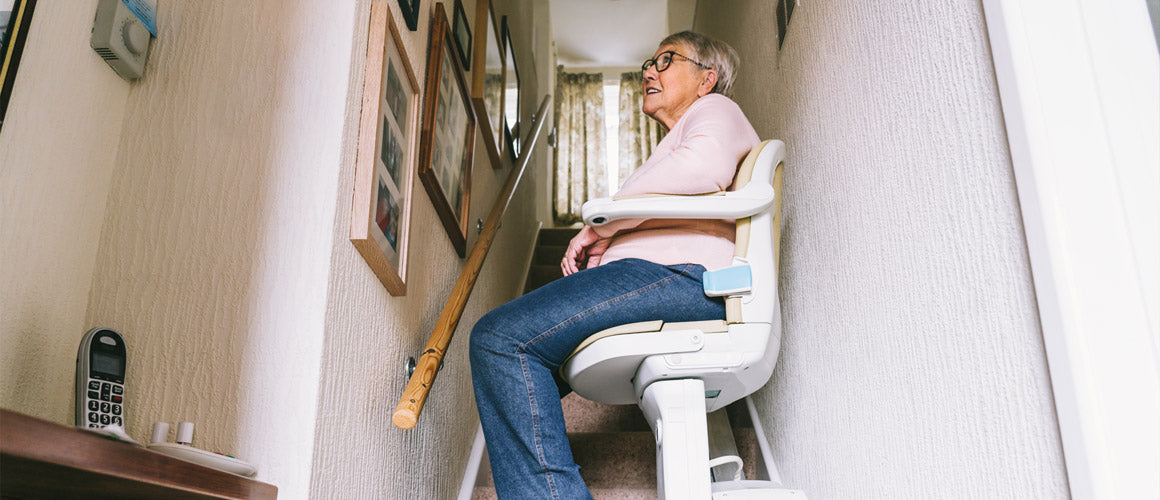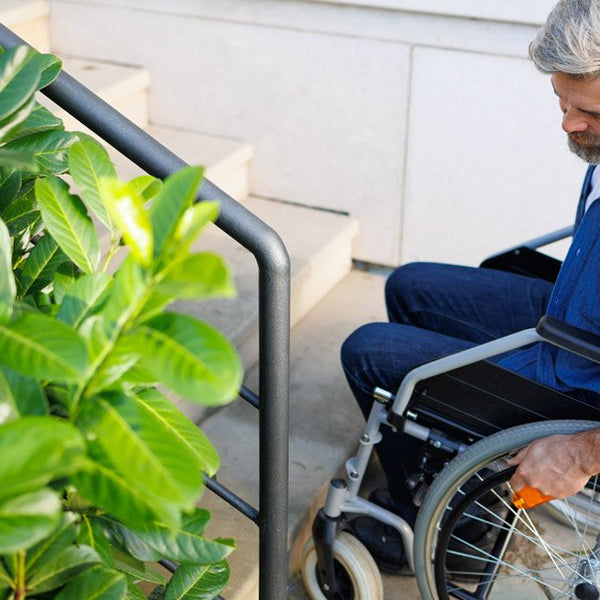As we age, often our mobility becomes limited due to aching or painful joints, or a disability or condition such as multiple sclerosis or osteoarthritis. Entering this new phase of your life, can require changes.
Some careful planning and preparation can make these changes less daunting. The continued development of functional furniture such as stairlifts, rise and recline chairs and independent living aids now means you can age confidently whilst living in your existing home and surroundings for longer, and it has never been easier or more varied.
The type of stairlift you choose will not only depend on your own mobility levels, but also the layout of your home. Every home is different, and so there are a range of lifts available to suit any circumstance. Whether your home has straight or curved stairs, indoor or outdoor steps, adapting the home or garden you love means you can remain in it for longer, so you can carry on making those sentimental memories.
In this article we’ll explore some of the options available and look at what’s involved to install them.
- What types of stairlifts are there?
- Finding a stairlift to blend with your home
- Making sure your stairlift has the right safety features
- Financing your stairlift
- Buying and installing a stairlift
- How long with installation take?
- Alternatives to a stairlift
- Maintaining your stairlift
- Extra reassurance with a personal alarm
What types of stairlifts are there?
Straight stairlifts

Where there are no turns or complex bends in your staircase, it is usually sufficient to run a straight stairlift track up the length of the stairs. A stairlift has a seat and carriage that runs up and down a staircase on a rail. This rail is fixed to the stairs, making fitting and removal straightforward with minimal disturbance. All stairlifts are battery driven with the battery charger running on a standard plug socket and cost only as much to run as boiling your kettle.
A straight stairlift is usually the simplest, cheapest and easiest to install with minimal disturbance to your home.
Curved stairlifts

If there are curves, landings or bends in your staircase you may require a curved stairlift. It’s important for your supplier to take precise measurements of your staircase using a camera and computer software, and send that information to the manufacturer to make a bespoke rail for your staircase. The rail is constructed in their factory using the latest fabrication techniques to ensure a smooth ride the entire length of the stairs. It can then be fixed neatly and quickly to the stairs with little inconvenience.
Curved stairlifts are made individually to fit your particular staircase and take a little longer to install.
Outdoor stairlift solutions
For your home entrance or to allow access to areas of your garden, such as patios or decking, you may need an outdoor stairlift. Whether you have a long flight of outside stairs or just a few steps going down to the basement or up to the garden, installing a stairlift provides a comfortable, safe and reliable way to ensure external steps are never a problem again.
Similar to indoor stairlifts, they consist of a seat and carriage that run up and down a staircase on a track.
Outdoor stairlifts are weather-resistant to withstand the elements.
Through-floor lifts
Through-floor lifts are a modern and unobtrusive solution for access within the home, allowing you to make full use of your living space. Domestic home lifts can offer a sleek design that fits in with any style of interior. With varying sizes and features, they have the ability to fit almost anywhere in the home, so you can either create a unique feature or a discrete look, whilst staying critically practical.
Through-floor lifts are cleverly engineered to be spacious while maintaining a compact footprint. They are comfortable to ride in, easy to use, quiet, economical to run and safe enough to even fit your family pet in with you.
Installation of a through-floor lift is fairly straightforward. Once any preparatory work has been completed, such as electrical work or pipework, a lift can usually be installed within a couple of days.
Steplifts and platform lifts

When wheelchair access is obstructed by steps, a ramp is not always a feasible solution. A practical and cost-efficient option, steplifts are designed for short-travel and are therefore quite compact lifts used to provide wheelchair access over a few steps to a front entrance.
A platform lift is a powered platform designed to raise a wheelchair and its user over steps or other vertical barriers. It can cover a height of a few steps to a few floors, depending on the make and model.
Finding a stairlift to blend with your home
It’s important that whatever option you choose, it fits in with your home’s decor and style. Many stairlifts come with customisable options, such as coloured fabric, different trims and rail colours, in order to complement your surroundings.
Many suppliers, such as Dolphin South West, have showrooms so you can view and try the stairlifts they sell. Find your local suppliers and visit their showrooms to find out more.
Making sure your stairlift has the right safety features
All stairlifts should meet European Standard BS EN 81-40-2020, as well as the relevant European CE marking.
European Standard BS EN 81-40-2020 requires a number of safety features including:
- Delay mechanism – after the start button has been pressed, the lift will delay a few seconds before moving to ensure you are ready.
- Overspeed governor – ensures the lift travels at no more than 0.15m every second
- Obstruction sensor – automatically stops the lift if any obstruction on the stairs is encountered
- Lockable on/off switch – useful safety feature if children are around
- Flame retardant fabric – all upholstered seats and plastics must be flame retardant
Through-floor lifts should meet British Standard BS5900, which covers the use of powered home lifts.
Financing your stairlift
A stairlift will be one of the more significant pieces of equipment you will buy to make your home easier to live in and to help you stay independent for longer. If you’re unable to fund it yourself, you may be able to access a grant or other financial help.
Local authority grants are available for house adaptations and equipment. Disabled Facilities Grants (DFGs) are available to disabled people who own or rent their home. They can also be paid to landlords on behalf of tenants.
Means-tested, the amount you will receive depends on your income and savings. The process can take several months and may be subject to a priority waiting list.
You may qualify for a DFG if having a stairlift is essential to allow you to move around your home, or if your disability stops you from climbing the stairs or reaching an essential facility upstairs, such as a bathroom.
If your property is owned by a housing association you may also be eligible for similar grants.
If, however, you do not qualify for a grant or it only partially covers the cost of the work, and you are unable to afford the sum required, social services or some charitable organisations may be able to provide some assistance.
Buying and installing a stairlift
When you’re ready to buy a stairlift, it’s a good idea to choose a supplier that will work with you to find the best solution for your needs. We’ve produced a handy checklist below of points you might want to consider before purchasing:
- Your mobility needs – is a stairlift the best solution for your individual circumstances?
- What type of stairs or what available space do you have, to determine which type of stairlift best suits your home layout?
- Do you have funds to purchase a stairlift or will you be able to receive a grant?
- Will any preparatory work need to be completed prior to installation, such as moving electrical wiring or pipework?
- Are you able to visit a showroom to see some stairlift options first hand?
- How will you maintain your stairlift after installation?
Make sure that your supplier completes a survey of your home to enable them to tailor a solution to suit, and also provides a full quotation of what is included. If your supplier has a showroom, pop along to see the options and try them out.
When you’re ready to place your order, your installer should ensure that any further appointments pre-installation are completed, then once a delivery date is set, an engineer should install the lift in your home, remove all packaging and leave everywhere clean and tidy.
How long with installation take?
Installation of a straightforward stairlift inside a home can usually be completed in a day and generally does not require planning permission.
Platform lifts, however, may require a planning application, so it is always best to check with your local authority in this case.
If your home is a listed building you may require Listed Building Consent prior to any work being carried out.
Alternatives to a stairlift

There are other options you could consider instead of installing a stairlift, though these could prove more costly.
If you struggle to access all areas of a property with more than one storey, you could consider moving to a more manageable home or into a bungalow where you no longer need to deal with stairs on a daily basis.
Alternatively, you could consider adapting the ground floor of your existing home to include sleeping and bathing arrangements on one level.
Maintaining your stairlift
Once your lift has been installed you will want to keep it running smoothly. Your initial warranty should include call-outs, repairs and labour, but some suppliers also offer comprehensive aftercare packages, which extend over and above any warranty in place.
Once you’ve had your stairlift installed, call-outs, repairs and labour should all be included in the initial warranty, but aftercare of the equipment is often overlooked. Choose a company that offers to look after your stairlift even after the initial warranty has expired. An ongoing service contract or one-off servicing can ensure your stairlift remains in good, safe working order and can really offer peace of mind.
Antonia Nixon
Dolphin Stairlifts South West
Extra reassurance with a personal alarm
Many people who are starting to feel a little unsteady on their feet are reassured by having a monitored personal alarm to provide extra support as they move around their homes or when out-and-about. These small, wearable pendant alarms allow you to call for emergency assistance any time of the day or night, should you fall, feel unwell or feel unsafe inside or outside of your home.
At the press of a button, a two-way communication feature allows you to talk directly to a highly trained Emergency Resolution Team, who will be able to alert nominated friends or family to provide assistance, or if necessary, contact the emergency services.
Personal alarms and fall alarms can prove a cost-effective alternative to care and can provide valuable peace of mind for the wearer and their families.




